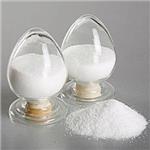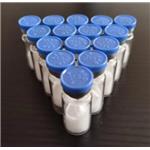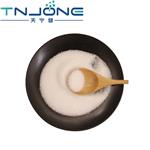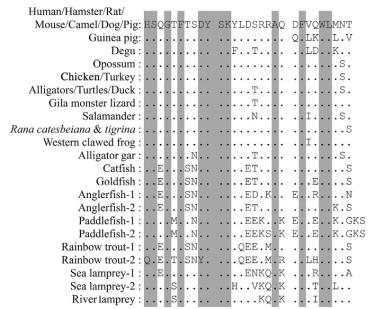- Glucagon
-

- $9.90 / 1kg
-
2024-04-26
- CAS:16941-32-5
- Min. Order: 1kg
- Purity: 99%
- Supply Ability: 100kg
- Glucagon
-

- $30.00 / 1box
-
2024-04-26
- CAS:16941-32-5
- Min. Order: 1box
- Purity: 98%
- Supply Ability: 2000kg
- Glucagon
-

- $0.00 / 1g
-
2024-04-15
- CAS:16941-32-5
- Min. Order: 1g
- Purity: 99%
- Supply Ability: 1000kg
Related articles - What is Glucagon?
- Glucagon regulates blood sugar, which is the opposite of insulin.
- Sep 25,2023
|
| | Glucagon Chemical Properties |
| density | 1.53±0.1 g/cm3(Predicted) | | storage temp. | Keep in dark place,Sealed in dry,2-8°C | | solubility | Practically insoluble in water and in most organic solvents. It is soluble in dilute mineral acids and in dilute solutions of alkali hydroxides. | | form | powder | | Water Solubility | Soluble to 1 mg/ml in water | | InChIKey | MASNOZXLGMXCHN-SXVMFYJYNA-N |
| WGK Germany | 3 | | F | 3-10-21 | | HS Code | 2937190000 |
| | Glucagon Usage And Synthesis |
| Discovery | Glucagon was first described in 1923 as an additional
substance with hyperglycemic properties from pancreatic
extracts. The amino acid sequence of glucagon was determined in the 1950s. After the establishment of a specific
radioimmunoassay in the 1970s, the role of glucagon in
physiology and disease was rapidly elucidated. The
entire coding sequence of the preproglucagon gene was
initially characterized in anglerfish by using the recombinant DNA technique. | | Structure | Glucagon is a single-chain polypeptide that contains
29 aa residues in all vertebrate species except the paddlefish, in which glucagon is 31 aa long. The primary structure of glucagon is identical in most mammals,
including humans. The N-terminal two aa residues are
cleaved off by dipeptidyl peptidase 4 (DPP-4) and the
truncated glucagon fragment, glucagon (3–29), is a partial
agonist of the glucagon receptor but shows no glycemic
effect in vivo. Human glucagon: Mr 3483, theoretical pI 6.75. Crystalline glucagon is a white to off-white powder. Glucagon is
relatively insoluble in water, methanol, ethanol, and
ether, but soluble at a pH<3 or>9.
 | | Clinical implications | Hyperglucagonemia is usually caused by the excessive
production of glucagon by a tumor of the pancreatic α
cells (glucagonoma). Hyperglucagonemia can also occur
in diverse conditions such as acute pancreatitis, severe
stress, acromegaly, Cushing’s syndrome, hepatocirrhosis, chronic hepatitis, chronic renal insufficiency, diabetic
ketoacidosis, prolonged starvation, hypercorticism, septicemia, and familial hyperglucagonemia. Manifestations
of hyperglucagonemia include dermatitis, diabetes, diarrhea, weight loss, abdominal pain, anemia, and thromboembolic disease. Hypoglucagonemia is rare, and can
occur in conditions such as chronic pancreatitis, anterior
pituitary failure, Addison’s disease, and glucagon
deficiency. | | Polypeptide hormone with straight-chain | Glucagon, also known as glucagon, is a straight-chain polypeptide hormone secreted by pancreatic islet α cells, containing 29 amino acids, with molecular formula and relative molecular mass of C153H225N43O49S = 3482.8. China has synthesize this hormone. It is a kind of white, odorless, and tasteless fine crystalline powder at room temperature. Glucagon is nearly insoluble in water and most organic solvents, while it is soluble in dilute acid and dilute alkali solution. Most of the preparation are hydrochloride which is dissolved in water. It is known that glucagon must retain its molecular integrity in order to exert its physiological activity. The glucagon structure of human and mammalian (rabbit, bovine, porcine, rat, etc.) may be consistent, while slightly different birds.
It is an important hormone to maintain normal blood glucose. The main role of glucagon is to activate the myocardium phosphorylation enzymes, promote glycogen breakdown and have a similar role of catecholamines. Therefore, it has a cardiac effect, making heart rate, myocardial contractility and coronary blood flow increased. Cardiac function is not associated with increased excitability of the heart, while it will make more calcium into the myocardial cells and can activate the adenylate cyclase of the liver cell membrane, thus promoting intracellular cyclization-synthesis of adenosine phosphate. Glucagon has been reported to be effective in certain heart failure cases. In addition, in the state of diabetes, liver disease, kidney disease, glucagon and stress, etc., the plasma levels are also increased to varying degrees. Glucagon owns four major physiological roles of the promotion of liver glycogen breakdown, glycogen gluconeogenesis, lipolysis and ketone body formation. It can promote the uptake of amino acids in liver cells, accelerate the process of amino acid deaminization in the liver, reduce the concentration of plasma amino acids, reduce the synthesis of protein, and promote liver glycogen. In addition, it can activate the lipase capacity of fat cells in the liver, increase the release of free fatty acids, speed up the process of lipid oxidation of liver cells, and increase the liver gluconeogenesis and ketone body. At the same time glucagon can inhibit the tension and peristalsis of stomach, small intestine and colon; reduce gallbladder tension; inhibit the process of pancreatic exocrinosity and the absorption of intestinal mucosa of water and salt. Large doses of glucagon can also increase concentration of myocardial cAMP, the heart rate and myocardial contractility. | | Pharmacological effects | The main role of glucogon is to promote the decomposition of glycogen and the production of glucose to elevate blood sugar; secondly, it also can promote lipolysis by leaving cyclic AMP (cAMP) levels increased via adenylate cyclase, thereby activating protein kinase and tissue lipase; in addition, through the activation of cardiac adenylate cyclase system, and promoting myocardial phosphorylase activity, it can increase the accumulation of calcium in the myocardium, thereby enhance myocardial contractility, increase cardiac output and blood pressure; It can promote insulin, somatostatin, thyroxine and calcitonin secretion; moreover, promote sympathetic and pheochromocyte catecholamines release. Through glucagon and insulin, somatostatin co-regulation, blood sugar maintained at the normal range. The secretion of glucagon is inversely proportional to the concentration of glucose in the blood, and the secretion of glucagon is also affected by the contents of amino acids, plasma free fatty acids, α-adrenergic receptor stimulator (norepinephrine), growth hormone releasing inhibiting hormone and other factors.
Glucagon is a single chain polypeptide hormone synthesized and secreted by islet α2 cells and it is a physiological antagonist of insulin. The impact on metabolism is similar to epinephrine. It has the following effects:
1. Blood glucose elevating effects: it can activate the phosphorylase in the liver, promote hepatic glycogen decomposition and gluconeogenesis, thus increasing blood sugar.
2. Positive inotropic action: it can increase intracellular cAMP levels, enhance myocardial contractility, increase cardiac output and stroke volume. Its positive inotropic effect can still manifest when applied with sufficient cardiac glycoside, and it will not be blocked by propranolol. Although it can increase heart rate and blood pressure, but will not cause arrhythmia. The mechanism is as follows: ①the activation of adenylate cyclase turned adenosine triphosphate into cyclization of adenosine monophosphate, making the myocardial contractility increased;
② promoting liver glycogen breakdown and increasing blood glucose levels;
③ promoting insulin release, improving the use of myocardial glucose and promoting myocardial anaerobic glycolysis, thereby improving myocardial energy metabolism. When combined with digitalis cardiac glycosides, It can increase the efficacy.
3. The role on the kidney: expanding renal blood vessels, improving renal blood flow, and promoting the excretion of sodium, potassium and calcium.
4. The role on the digestive system: it can cause the smooth muscle relaxation of stomach and duodenum, small intestine and colon and inhibit stomach, small intestine and colon peristalsis, increase the secretion of bile and intestinal fluid.
5. The role on the secretion system: exciting adrenal medulla, promoting the release of catecholamines. It can also promote insulin, thyroid hormone, calcitonin and growth hormone secretion. | | Indications | Oral administration of this product is invalid, injection treatment is frequently applied. The action time in vivo is short; it will work after 5 minutes of intravenous injection. Blood glucose can be increased by 50% in 30 minutes. It is sustainable about 1 hour. It mainly inactivated in the liver, kidney and plasma. Plasma half-life time is 3 to 6 minutes. In clinical practice, it is used for insulin-dependent diabetes patients with severe hypoglycemic coma and the disability to eat, but also for the determination of pancreatic function, diagnosis of pancreatic tumor and pheochromocytoma. It is mainly used for acute heart failure, digitalis ineffective heart failure, heart failure with cardiogenic shock for circulatory system use. The efficacy of glucagon on chronic heart failure is poor. The main indications are as follows:
① acute low-emission syndrome.
② coronary heart disease and cardiomyopathy caused by acute heart failure or cardiogenic shock.
③ arrhythmia caused by the combined treatment of propranolol to digitalis poisoning. | | Usage and dosage | 3~5mg for the first administration; intravenous injection of glucose solution. If there are no adverse reactions after 2~5min , intravenous infusion rate of 2.5~10mg/h is available. It will work after 1~3min of intravenous injection, 10min arrives at the peak, 30min effect disappears. It can be applied 24h continuously depending on the medical necessity.
Intramuscular, subcutaneous or intravenous: hypoglycemic coma, 0.5~1mg, if necessary, re-administration every 20 minutes. 5 to 20 minutes can be effective. If after 1 hour is still invalid, use of glucose as soon as possible. The dose for children is 5μg/kg.
Vein dropping: diluted infusion of 5% glucose injection. Congestive heart failure, 2.5~7.5mg per hour. Cardiogenic shock; 1~12mg per hour as the medical necessity; sustainable 24 hours intravenous infusion. | | Side effects | Too large or too fast not only can cause nausea, vomiting, but also hypokalemia, high blood sugar and bleeding tendency. | | Chemical Properties | White or almost white powder | | Uses | Glucagon has been used:
- in the stimulation of human primary hepatocytes for cyclic adenosine monophosphate (cAMP) production
- for measuring glucagon response in mice
- to induce gluconeogenic stimuli in primary hepatocytes
| | Uses | Hypoglycemia?(diabetes?mellitus) | | Uses | Glucagon is a polypeptide secreted by the α cells of the pancreatic islets. Its
physiological actions include stimulation of hepatic gluconeogenesis in
response to hypoglycaemia and amino acids and as part of the stress
response. These effects are mediated by increasing adenylate cyclase activity
and intracellular cAMP by a mechanism independent of the β-adrenergic
receptor. It increases cAMP in myocardial cells and so
increases cardiac contractility. Glucagon causes nausea and vomiting,
hyperglycaemia and hyperkalaemia and is not used as an inotrope except in
the management of β-blocker poisoning. | | Uses | Glucagon is an Amino Acid sequence. | | Definition | Produced by the α cells of the islands of Langerhans and also by the gastric mucosa. It is opposite in
effect to insulin. It appears to be a straight-chain polypeptide with a molecular weight of approximately 3500. Small amounts have been detected in comm | | Biological Functions | Glucagon, a 29-amino-acid, straight-chain polypeptide of α-cell pancreatic origin, triggers liver
glycogenolysis and gluconeogenesis, thereby elevating glucose levels. The principal action of
glucagon is the liver-mediated release into the blood of abnormally high concentrations of
glucose, which causes hyperglycemia. This means that glucagon has an effect on blood glucose
levels that is opposite to what occurs with insulin. | | General Description | produced by recombinant DNA technology ismarketed by Novo Nordisk (glucagon [recombinant] hydrochloride,GlucaGen HypoKit, GlucaGen Diagnostic Kit)and by Eli Lilly (glucagon [recombinant] Emergency Kit). | | General Description | The hyperglycemic–glycogenolytic hormone elaborated by the α-cells of the pancreas is known as glucagon. It contains 29 amino acid residues. Glucagon has been isolated from the amorphous fraction of a commercial insulin sample (4% glucagon).
It is soluble, 1 to 10 mg/mL, in the pH ranges 2.5 to 3.0 and 9.0 to 9.5. Solutions of 200 μg/mL at pH 2.5 to 3.0 are stable for at least several months at 4°C if sterile. Loss of activity by fibril formation occurs readily at high concentrations of glucagon at room temperature, or above, at pH 2.5. The isoelectric point appears to be at pH 7.5 to 8.5. Because it has been isolated from commercial insulin, its stability properties should be comparable to those of insulin. | | Biochem/physiol Actions | Glucagon functions to elevate glucose by activating GCGR in liver mediating the glucose circulation in blood. The hyperglucagonemia elevated levels of glucagon is observed in diabetes and in nonalcoholic fatty liver disease, post gastric bypass surgery and glucagon based tumors. | | Clinical Use | Endogenous glucagon isproduced from the gene-derived protein PG in the cells ofthe islets of Langerhans in the pancreas. The core functionof this hormone is to renormalize blood glucose levels whenthey fall too low, by stimulating production from glycogen stores in liver and muscle, and stimulating hepatic gluconeogenesis.Glucagon also elicits biochemical processes (suchas fatty acid oxidation) that supply the needed precursors forgluconeogenesis. Glucagon supplied exogenously (i.e., injected)in response to emergency hypoglycemia acts rapidlyto elicit these same responses. Clinically, glucagon also providesan alternative to cholinergic antagonists for reducingGI motility and secretory activity during radiologic imagingprocedures. | | Clinical Use | The glucagon test is performed to identify glucagonoma. It is also performed clinically to measure glucose
control in patients who have developed type 2 diabetes,
or in patients who may be insulin-resistant. Glucagon
administration is used in the treatment of hypoglycemia,
in anaphylactic reaction in patients on beta-blocker therapy, in beta-blocker- or calcium channel blocker-induced
myocardial depression unresponsive to standard measures, and in the temporary inhibition of gastrointestinal
movement during radiologic examinations. | | Veterinary Drugs and Treatments | In small animals, the primary use for glucagon is to increase blood
glucose in patients with excessive insulin levels, either endogenously
produced (insulinoma) or exogenously administered (insulin
overdose). Glucagon has potential in the treatment of fatty liver
syndrome in dairy cattle.
In human medicine, glucagon is used in treating the cardiac
manifestations of beta-blocker and calcium-channel blocker overdoses.
One study (Kerns, D et al. 1997) in dogs, however, demonstrated
insulin to be superior to glucagon in treating experimental
propranolol overdoses in dogs. | | storage | Store at -20°C |
| | Glucagon Preparation Products And Raw materials |
|